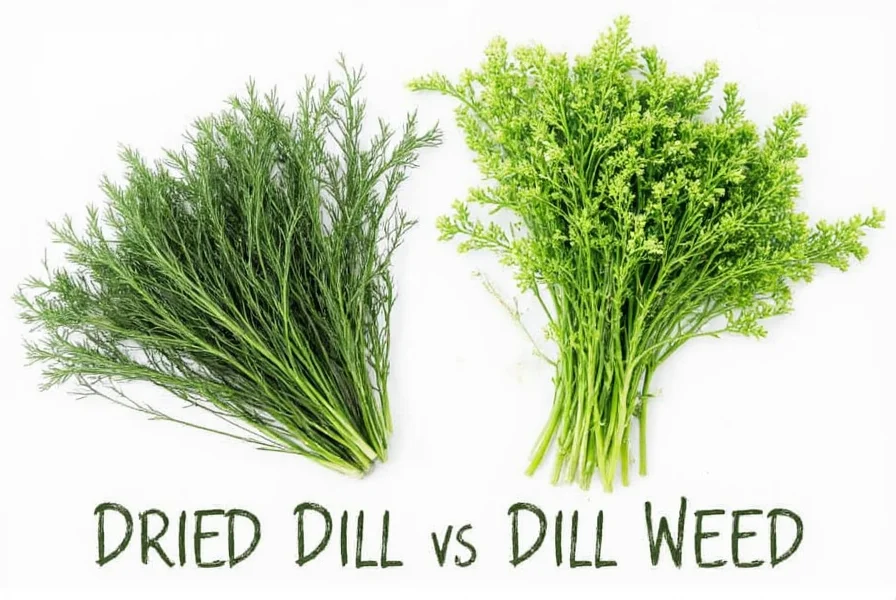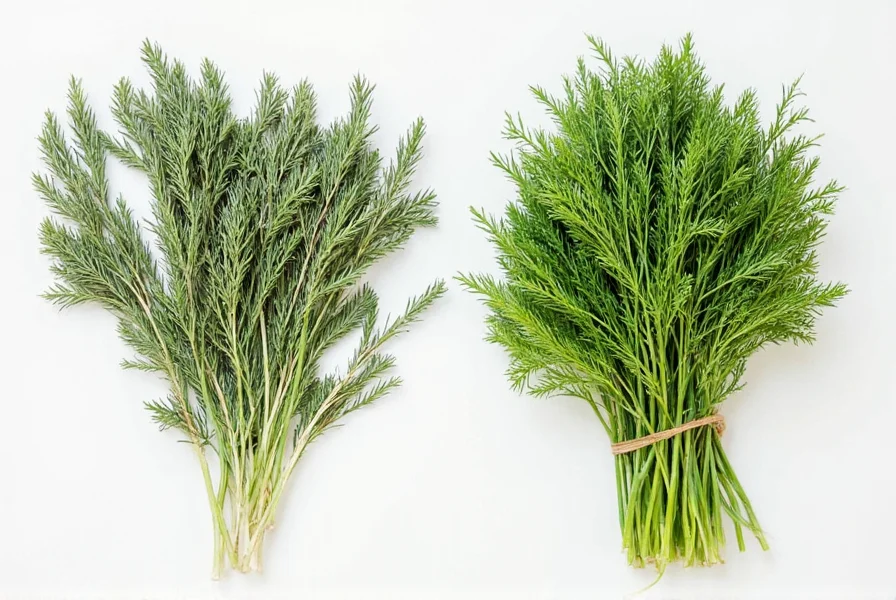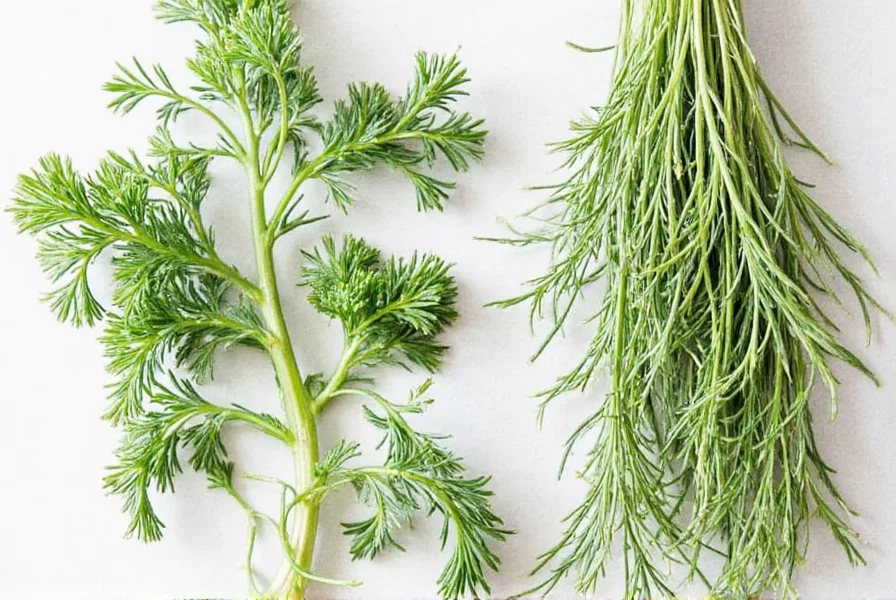Understanding the distinction between dried dill and dill weed matters significantly for home cooks and culinary enthusiasts. Many recipes call for one form or the other without explaining the difference, leading to potential flavor imbalances in dishes. This confusion stems from inconsistent labeling practices and regional terminology variations that have persisted in the culinary world.
What Exactly Is Dill Weed?
Dill weed describes the fresh, delicate leaves of the dill plant. When you see "dill weed" on a spice bottle in the grocery store, it actually contains dried dill leaves—not fresh ones. This labeling convention causes considerable confusion. True dill weed in its authentic form comes straight from the garden: vibrant green, feathery fronds with a subtle, grassy aroma and mild anise-like flavor.
The term "weed" in this context doesn't imply an undesirable plant but rather distinguishes the leafy portion from dill seed (the plant's fruit). Botanically speaking, dill weed refers to the entire above-ground portion excluding seeds.
Dried Dill: Preservation and Potency
Dried dill undergoes a dehydration process that removes moisture while concentrating essential oils and flavor compounds. This preservation method extends shelf life from days to months but alters both flavor profile and potency. The drying process causes chemical changes that intensify certain compounds while diminishing others, resulting in a more robust, slightly different flavor profile compared to fresh dill.
When properly dried and stored, dill retains much of its characteristic flavor, though it loses some of the bright, grassy notes present in fresh dill weed. The dried version develops deeper, earthier undertones that work well in certain applications but differ noticeably from the fresh herb.
Flavor Comparison and Culinary Impact
The flavor difference between dried dill and fresh dill weed significantly affects recipe outcomes. Fresh dill offers a delicate, bright flavor with subtle citrus and anise notes that dissipate with heat. Dried dill provides a more concentrated, earthier taste that withstands cooking better but lacks some of fresh dill's complexity.
| Characteristic | Fresh Dill Weed | Dried Dill |
|---|---|---|
| Flavor Intensity | Mild, delicate | 3-4 times more concentrated |
| Best Used In | Cold dishes, finishing touch | Cooked dishes, marinades |
| Shelf Life | 3-7 days refrigerated | 1-3 years stored properly |
| Flavor Notes | Grassy, citrusy, subtle anise | Earthy, stronger anise, less bright |
Substitution Guidelines for Perfect Results
Knowing how to substitute between dried dill and dill weed prevents recipe disasters. The general conversion ratio follows the standard dried-to-fresh herb rule, but dill requires special consideration due to its delicate nature:
When substituting dried dill for fresh dill weed, use one-third the amount of dried dill. For example, if a recipe calls for 3 tablespoons of fresh dill weed, use 1 tablespoon of dried dill. The reverse substitution requires tripling the amount—1 tablespoon of dried dill equals approximately 3 tablespoons of fresh dill weed.
However, this standard ratio doesn't tell the whole story. Because fresh dill loses flavor quickly when cooked, while dried dill benefits from some cooking time to rehydrate and release flavors, the substitution isn't always mathematically precise. In cold applications like dips or salads, you might need to adjust the ratio slightly downward for dried dill, as its flavor doesn't mellow in the same way.
When to Choose Each Form
Culinary professionals select between dried dill and fresh dill weed based on specific dish requirements. Fresh dill weed shines in applications where its delicate flavor can remain prominent:
- Cold sauces and dips (tzatziki, dill dip)
- Salmon and seafood dishes (added at the end)
- Vinegar-based pickles
- Finishing touch for soups and salads
Dried dill performs better in situations requiring longer cooking or where a more robust dill flavor is desired:
- Marinades that require time to penetrate
- Casseroles and baked dishes
- Dry rubs for meats
- Brine solutions for pickling
- Commercial spice blends

Storage Techniques for Maximum Freshness
Proper storage dramatically affects the shelf life and flavor retention of both forms. For fresh dill weed, treat it like delicate flowers: trim the stems, place in a glass with an inch of water, cover loosely with a plastic bag, and refrigerate. Change the water every two days. This method typically extends freshness to 7-10 days.
Dried dill requires protection from three enemies: light, heat, and moisture. Store in an airtight container away from the stove or sunlight. For longest shelf life, keep dried dill in the freezer where it maintains potency for up to three years. The refrigerator works but exposes the herb to moisture fluctuations that degrade quality faster.
Common Misconceptions Clarified
Several persistent myths confuse home cooks about dried dill versus dill weed. First, "dill weed" on spice jars doesn't indicate a different plant variety—it's simply dried dill leaves. Second, dried dill isn't "stronger" in all contexts; while more concentrated by volume, it lacks some flavor compounds present in fresh dill.
Another misconception suggests dried dill works equally well in all applications where fresh dill appears. In reality, certain dishes like Scandinavian gravlax or Greek tzatziki fundamentally change character when made with dried instead of fresh dill. The texture and volatile oils that define these dishes require fresh dill weed for authenticity.
Practical Tips for Cooking Success
Maximize your dill usage with these professional techniques. When using dried dill in cooked dishes, add it early enough to rehydrate—about 15-20 minutes before completion. For cold applications, briefly steep dried dill in a small amount of warm water or vinegar before adding to help release flavors.
Revive stale dried dill by placing the container in a 200°F (95°C) oven for 5-10 minutes, then immediately transferring to an airtight container. This drives out residual moisture that causes staleness without burning the delicate herb.
For the best flavor in critical dishes, consider making your own dried dill from fresh. Air-dry small bunches upside down in a dark, well-ventilated space. This preserves more flavor compounds than commercial drying methods, resulting in superior quality compared to store-bought dried dill.

Understanding Labeling Confusion
The persistent confusion between dried dill and dill weed stems from inconsistent labeling practices. In grocery stores, you'll typically find two products: "dill weed" (which contains dried dill leaves) and "dill seed" (the plant's fruit). The term "dill weed" on spice jars refers to dried dill leaves, not fresh ones—a significant source of misunderstanding for novice cooks.
This labeling convention developed because "dill weed" distinguishes the leaf portion from dill seed in botanical terminology. When dried for commercial sale, the product retains the "dill weed" name despite being dehydrated. Understanding this terminology quirk helps navigate recipe requirements and grocery store selections with confidence.











 浙公网安备
33010002000092号
浙公网安备
33010002000092号 浙B2-20120091-4
浙B2-20120091-4